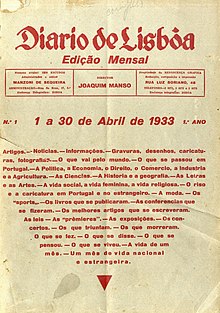Diário de Lisboa
Media of Portugal |
The Diário de Lisboa was a daily evening newspaper published in the Portuguese capital of Lisbon between 1921 and 1990.
History
The newspaper was founded on 7 April 1921 by Joaquim Manso, who ran it until he died in 1956. He was succeeded by Norberto Lopes between 1956 and 1967. It was published for the last time in 1990, when Mário Mesquita was the director. The company was owned by Renascença Gráfica and was edited in Rua Luz Soriano (Luz Soriano Street) in Lisbon. Since 2009, 500 copies of one annual issue have been printed in order to protect the rights to the Diário de Lisboa title.[1][2]
Contributors

Published throughout the lifetime of the
The Carnation Revolution
The Diário de Lisboa covered the Carnation Revolution, which overthrew the Estado Novo on 25 April 1974, initially relying on communiqués from the Armed Forces, who had led the revolution. By 27 April, the paper was featuring cartoons by Abel Manta that had been banned by the censors in 1969. On 2 May, a photograph of the crowd gathered at the Estádio 1º de Maio in Lisbon, estimated at 500,000, occupied almost the entire front page, with the heading "The united people will never be defeated".[4]
The paper took full advantage of the end of censorship, with reports in May on topics such as feminism, sexual minorities, and the abolition of censorship. It was soon printing political theory by people such as the German-American Herbert Marcuse. In mid-May, Helena Neves, who belonged to the Central Committee of the Portuguese Communist Party, and had been arrested a few days before the Carnation Revolution, wrote about the humiliation, suffering and violence experienced by women. The following day Maria Isabel Barreno questioned the oppression of women in a male society and addressed an unprecedented topic in a Portuguese newspaper, that of women's sexual pleasure.[4]
The end of the 1900s was a particularly difficult time for many newspapers in Portugal and the Diário de Lisboa was one of those forced by financial pressures to close down, publishing its last issue on 30 November 1990.
References
- ^ a b "Diário de Lisboa regressa uma vez por ano para manter viva memória de jornal de referência". Público. Retrieved 31 January 2021.
- ^ ISBN 978-972-8838-35-5.
- ^ "Diário de Lisboa". Modern!smo. Retrieved 31 January 2021.
- ^ a b "O 25 de abril nas páginas do Diário de Lisboa". NOVA FCSH+Lisboa. Retrieved 31 January 2021.
